“For what daughter of Eve could forego ‘the cup that cheers’. ‘And although we often suffered terribly from want of water’, said Mrs. Bent as we chatted about her last journey, ‘I usually managed to have a cup of tea every morning’.”
“Mrs. Theodore Bent might claim, was she not a very modest woman, to be the champion lady explorer of modern times. Together with her husband, the late Mr. Theodore Bent, she has undertaken successfully 13 voyages of exploration, and probably few women are as familiar with the little known islands of Greece as is Mrs. Bent; she was also one of the first to traverse Arabia.” (Southampton Observer and Hampshire News – Saturday, 3 July 1897)
For Mabel Bent’s birthday, 28 January (she was born in 1847), we reprint below two interview-based articles about her that appeared in Lady of the House on 15 September 1893 and 14 July 1894. It is unlikely that they have seen the light of day since then. In their way, they are remarkable.
Now viewed by some as Ireland’s first magazine for women, Lady of the House was launched in 1890 in Dublin. This refined Irish magazine regularly, and unsurprisingly, published news of the activities of Mabel Bent, associated, as the latter was, with two eminent Irish families – the Lambarts of Co. Meath, and the Hall-Dares of Co. Wexford.
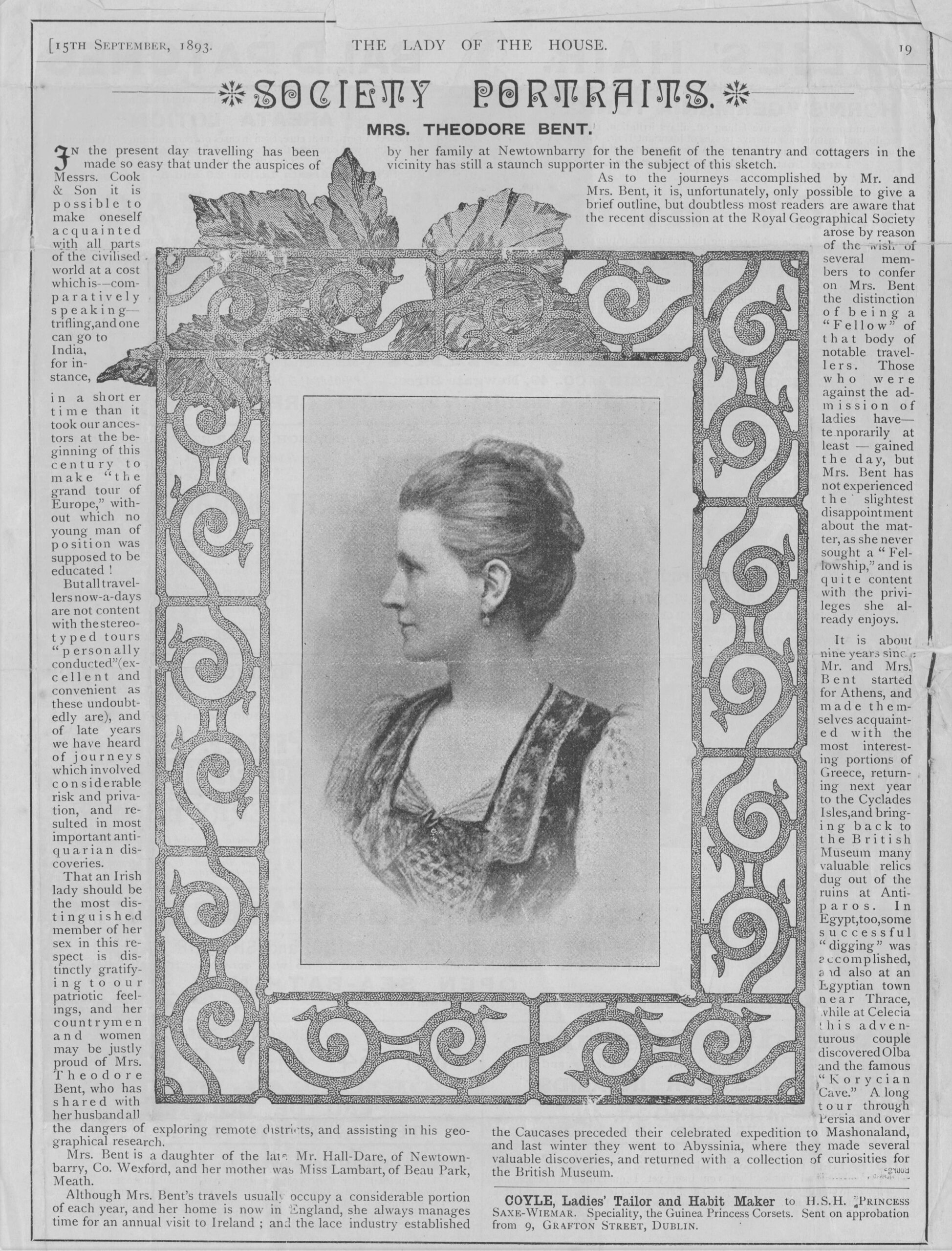
The magazine’s features team clearly recognised that news of Mabel was exactly the right fit for its modern readership. The relationship began, it seems, back in September 1893, when Mabel was the subject of a 500-word piece for the magazine’s ‘Society Portraits’ page: it may well have been based on an interview, and it’s great highlight is a photograph of Mabel in profile that has been much reproduced. As might be expected, the tone of the piece is more than a little hyperbolic, and there are some strange references, i.e. that the couple undertook ‘some successful “digging”’ in Egypt (this they did not, other than bury some picnic rubbish near the Sphinx!), and their work on the island of Thasos, northern Aegean, is relocated to ‘an Egyptian town near Thrace’. The concluding sentence is accurate however: ‘… and last winter [1892/93] they went to Abyssinia, where they made several valuable discoveries, and returned with a collection of curiosities for the British Museum’. The oblique reference to Mabel’s possible election to join the Fellows of the Royal Geographical Society is noteworthy – she was on the shortlist for the second tranche of women Fellows that year, but the RGS executive decided to stop the practice. Mabel is trying not to show disappointment (Theodore, of course, was a Fellow).
The same photograph of Mabel is used the following summer (14 July 1894) to trumpet the Bents’ epic foray into the remote and hazardous Wadi Hadramaut (Yemen) – Mabel is still thought to be the first ‘European’ woman to have (voluntarily) travelled there. The revelation of the piece is that they returned with “very valuable parchments, illuminated on almost every page, which are supposed to date from the time of Mahomed” [sic]. This is the first and only reference to such acquisitions, and where they might be now is anyone’s guess.
The journal continued to report on Mabel’s comings and goings after her widowhood (1897) and into the decades that followed – it may well be that it was supplied with ‘press releases’ direct from 13 Great Cumberland Place, Mrs. Bent’s London headquarters.
Lady of the House, 15 September 1893, page 19, ‘Society Portraits’ (c. 500 words):
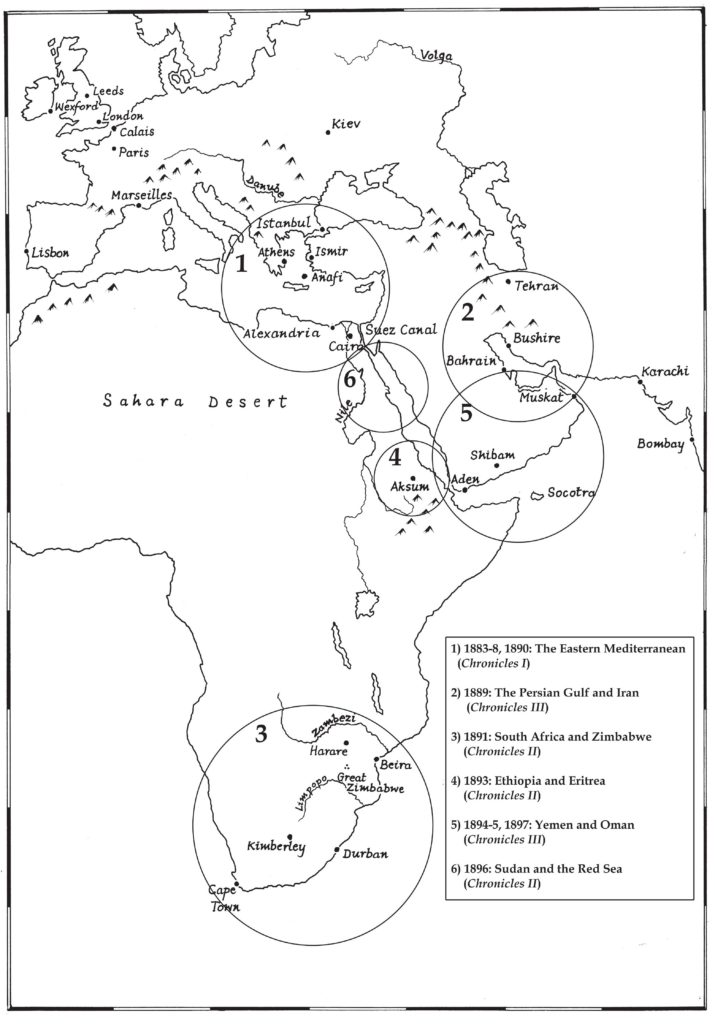
“In the present day travelling has been made so easy that under the auspices of Messrs. Cook & Son it is possible to make oneself acquainted with all parts of the civilised world at a cost which is – comparatively speaking – trifling, and one can go to India, for instance, in a shorter time than it took our ancestors at the beginning of this century to make ‘the grand tour of Europe’, without which no young man of position was supposed to be educated!
“But all travellers now-a-days are not content with the stereotyped tours ‘personally conducted’ (excellent and convenient as these undoubtedly are), and of late years we have heard of journeys which involved considerable risk and privation, and resulted in most important antiquarian discoveries. That an Irish lady should be the most distinguished member of her sex in this respect is distinctly gratifying to our patriotic feelings, and her countrymen and women may be justly proud of Mrs. Theodore Bent, who has shared with her husband all the dangers of exploring remote districts, and assisting in his geographical research.
“Mrs. Bent is a daughter of the late Mr. Hall-Dare, of Newtownbarry, Co. Wexford, and her mother was Miss Lambart, of Beau Park, Co. Meath.
“Although Mrs. Bent’s travels usually occupy a considerable portion of each year, and her home is now in England, she always manages time for an annual visit to Ireland; and the lace industry established by her family at Newtownbarry for the benefit of the tenancy and cottagers in the vicinity has still a staunch supporter in the subject of this sketch.
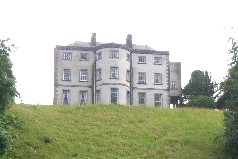
“As to the journeys accomplished by Mr. and Mrs. Bent, it is, unfortunately, only possible to give a brief outline, but doubtless most readers are aware that the recent discussion at the Royal Geographical Society arose by the reason of the wish of several members to confer on Mrs. Bent the distinction of being a ‘Fellow’ of that body of notable travellers. Those who were against the admission of ladies have – temporarily at least – gained the day, but Mrs. Bent has not experienced the slightest disappointment about the matter, as she never sought a ‘Fellowship’, and is quite content with the privileges she already enjoys.
“It is about nine years since Mr. and Mrs. Bent started for Athens, and made themselves acquainted with the most interesting portions of Greece, returning next year to the Cyclades Isles, and bringing back to the British Museum many valuable relics dug out of the ruins at Antiparos. In Egypt, too, some successful ‘digging’ was accomplished, and also at an Egyptian town near Thrace, while at Celecia this adventurous couple discovered Olba and the famous ‘Korycian Cave’. A long tour through Persia and over the Caucasus preceded their celebrated expedition to Mashonaland, and last winter they went to Abyssinia, where they made several discoveries, and returned with a collection of curiosities for the British Museum.”
Lady of the House, 14 July 1894, page 4, ‘In a Sultan’s Harem’ (c. 1000 words):
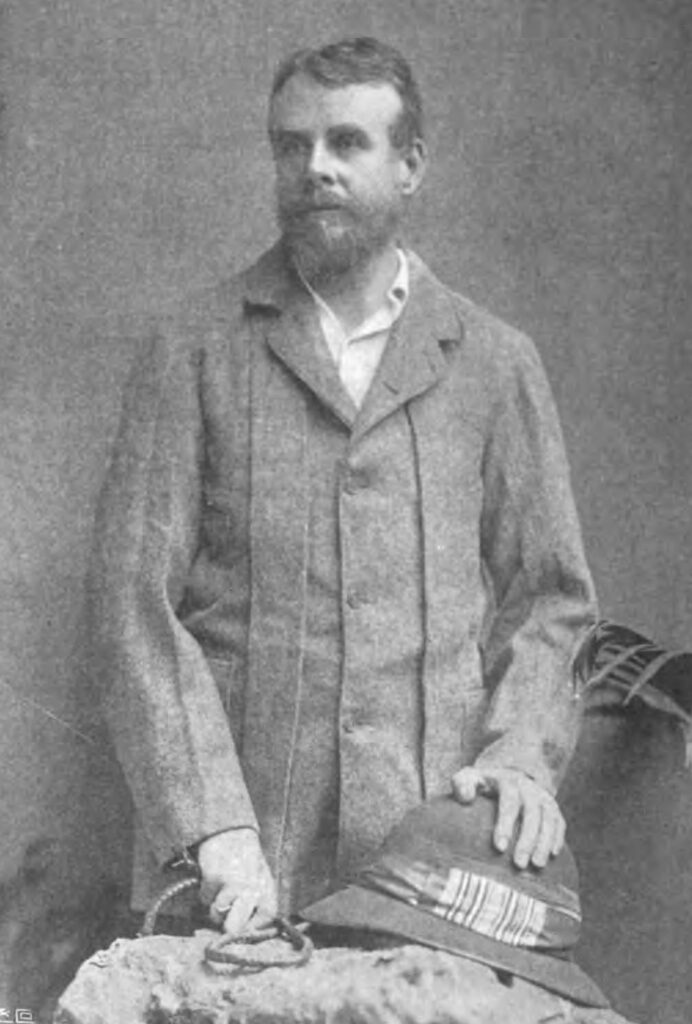
“Mrs. Theodore Bent’s name is so familiar to all who are versed in the events of the day, it is hardly necessary to remind our readers that this distinguished member of her sex is an Irishwoman, and therefore a brief account of her last journey cannot fail to have a special interest for her countrywomen. That Mrs. Bent is endowed with unusual courage and fortitude goes without saying, for perhaps no other woman has undertaken such arduous and dangerous journeys, nor assisted so indefatigably in the antiquarian research which is the raison d’être for Mr. Bent’s travels.
“After the unpleasant experiences in Abyssinia during the winter and spring of 1893, many of Mrs. Bent’s friends thought she would not be inclined to seek fresh dangers, but undeterred by what she had gone through, Mrs. Bent commenced preparations last autumn for the South Arabian expedition, as she invariably sees after the necessary camp furniture and provisions, the latter consisting principally of tinned meats, milk, etc., and, of course, tea. For what daughter of Eve could forego ‘the cup that cheers’. ‘And although we often suffered terribly from want of water’, said Mrs. Bent as we chatted about her last journey, ‘I usually managed to have a cup of tea every morning’.
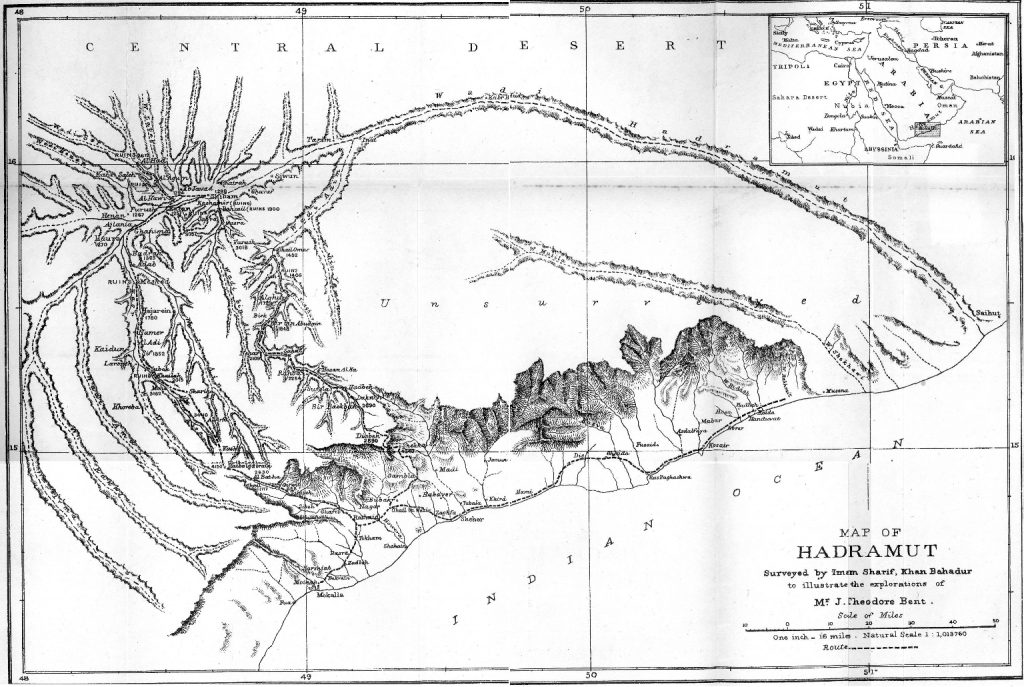
“Mr. and Mrs. Bent left England on the 24th November, accompanied by an Arab zoologist, a botanist (sent from Kew), a surveyor from the Indian Government, an archaeologist, and last, but certainly not least, by the faithful Greek servant who had attended the travellers throughout their former journeys, and an interpreter joined them on landing. Starting from Aden, the little party wended their steps towards the interior of South Arabia, camping out at night and by day riding on camels, with the exception of Mrs. Bent, to whom a horse had been presented by a friendly Sultan. Being extremely fond of animals (and of horses in particular), a warm friendship soon sprung up between owner and steed.
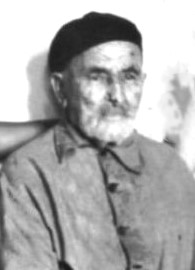
“To give in detail the story of Mr. and Mrs. Bent’s wanderings would be impossible in a necessarily limited space. Suffice it to say that often their path was rough and difficult, and dangers beset them on every side as they got further and further into the country, at length reaching a district where no European had ever entered. The natives – a very strict set of Mahommedans – were determined ‘the unbelievers’ should not pass though, and attacked the little party with their primitive, but dangerous, firearms, and on one occasion the travellers seemed to have slight chance of saving their lives. Yet in the midst of an unknown country, surrounded by foes, Mrs. Bent never once showed fear, though all the members of the expedition, save Mr. Bent and the Indian surveyor, completely lost hope, and gave vent to their terror unreservedly. Mrs. Bent kindly endeavoured to cheer the Greek servant, but he refused to be comforted, ‘although’, she added with a smile, ‘I reminded him we were the first Europeans who had entered the district, hoping he would consider this some compensation. But he replied sadly, “Yes, and probably we shall never leave it!”’ Unfortunately, the poor fellow was so terrified he refuses to accompany his master and mistress on their next visit to Arabia, a resolution which they much regret.
“But there were many pleasant incidents too connected with the months passed in that remote country, and I was greatly amused and interested in Mrs. Bent’s graphic account of a visit to the Palace of Shibam, where she was allowed to enter the harem and spend some time with its inmates. The Sultan of Shibam is the husband of thirteen wives, whose principal occupation seems to consist in painting their faces yellow, and decorating themselves with innumerable gold chains and ear-rings. One of these ladies has considerable influence with his dusky Majesty, and at her instigation he is now building another palace. But the other wives are decidedly stupid and uninteresting. The harem is hung with looking glasses, and furnished with the usual large and rather hard cushions and rugs, while the thirteen ladies wore the long shapeless dress of the country, made of indigo-dyed fine cotton, richly embroidered, in pale grey thread, and further ornamented with pieces of bright-coloured cottons, ingeniously arranged and set off by beads of several hues.

“Mrs. Bent showed me a facsimile of the Royal ladies’ apparel she was lucky enough to secure, and also the face mask worn by all the Southern Arabian women except in the privacy of the harem. It is indigo-dyed cotton, with two slits for the eyes, and an embroidered band which ties round the head. They also wear a heavy leather and brass girdle and brass anklets, which are well displayed in front, as the dress I have already described barely reaches to the knees, although hanging in a train at the back. The Sultan’s wives, Mrs. Bent told me, burn quantities of incense in the harem, and brought out boxes of gold chains for her edification. They glanced pityingly at her single pair of ear-rings, for with them this would be a mark of extreme poverty, and when they discovered she was Mr. Bent’s only wife, no doubt of his financial condition was entertained by them!
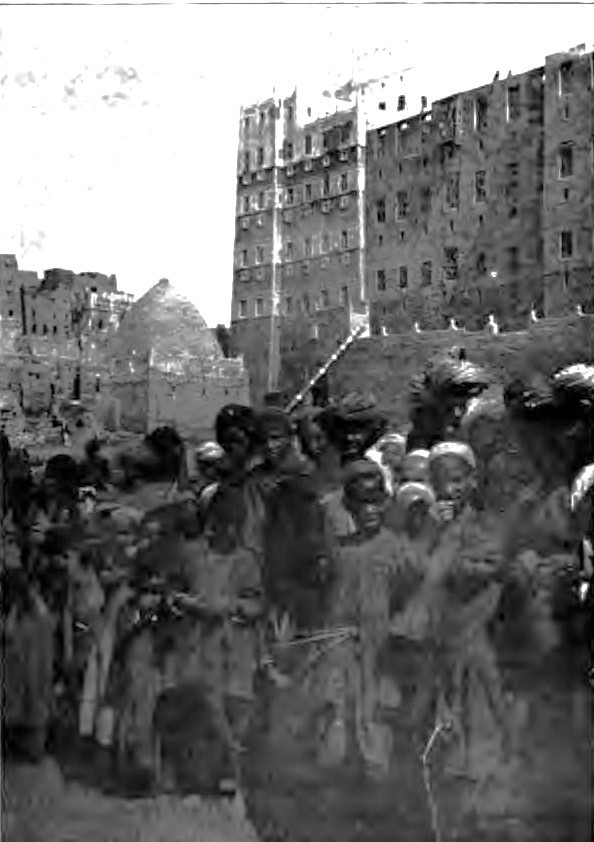
“But the Sultan, who saw Mrs. Bent doing embroidery (work in which she excels) and busying herself about household matters in the camp, came to the conclusion that one wife like her was of more value than his thirteen put together; and when he found how delightfully she can converse, this opinion was strengthened, for, as he candidly acknowledged, his wives were stupid and lazy! As Mrs. Bent hopes to return to Shibam next winter, let us hope the fair inhabitants of the palace have not heard their lord and master’s sentiments. By the bye, Mrs. Bent took a number of photographs in Arabia, including one of the Sultan, who looks as though he was thoroughly pleased with the attention, while a view of the palace gives one a good idea of that genial monarch’s home. Mr. Bent also has souvenirs of the journey in the form of admirable water-colour sketches, and the travellers’ collection of Arabian things embrace specimens of native workmanship and clothing, in addition to wonderful and very valuable parchments, illuminated on almost every page, which are supposed to date from the time of Mahomed.
“If all goes well, Mr. and Mrs. Bent intend starting about November for South Arabia, and penetrating further into the country than they have already done, when it is likely the records of the Royal Geographical Society may be further enriched by Mr. Bent’s explorations, and our charming countrywoman will have again proved what Irish ‘pluck’ can accomplish.”
[You might also enjoy other interviews with the Bents, see the Irish weekly The Hearth and Home (2 November, 1894) and The Album (8 July, 1895), as well as the feature in The Gentlewoman, 11 November, 1893] Leave a comment or contact us about this article
Leave a comment or contact us about this article